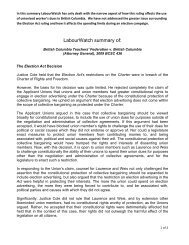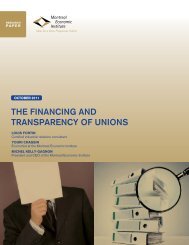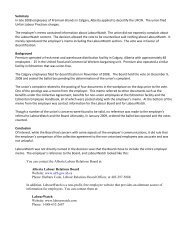Cross Canada Definition of "Union" - Public Sector - LabourWatch
Cross Canada Definition of "Union" - Public Sector - LabourWatch
Cross Canada Definition of "Union" - Public Sector - LabourWatch
Create successful ePaper yourself
Turn your PDF publications into a flip-book with our unique Google optimized e-Paper software.
www.labourwatch.com<br />
www.infotravail.ca<br />
CROSS-CANADA DEFINITION OF “UNION” – PUBLIC SECTOR<br />
Jurisdiction Statute Statute<br />
Uses<br />
“Trade<br />
Union”?<br />
<strong>Canada</strong> Parliamentary N<br />
Employment<br />
and Staff<br />
Relations Act<br />
<strong>Canada</strong><br />
British<br />
Columbia<br />
<strong>Public</strong> Service<br />
Labour<br />
Relations Act<br />
<strong>Public</strong> Service<br />
Labour<br />
Relations Act<br />
N<br />
N<br />
Legislation<br />
Reference<br />
Employee<br />
Organization<br />
Employee<br />
Organization<br />
Union<br />
Statute’s <strong>Definition</strong> <strong>of</strong> “Trade Union”<br />
“Union” or “Labour Organization<br />
s.3 - “employee organization” means any<br />
organization <strong>of</strong> employees the purposes <strong>of</strong> which<br />
include the regulation <strong>of</strong> relations between an<br />
employer and its employees for the purposes <strong>of</strong><br />
this Part and includes, unless the context<br />
otherwise requires, a council <strong>of</strong> employee<br />
organizations;<br />
s.2 - “employee organization” means an<br />
organization <strong>of</strong> employees the purposes <strong>of</strong> which<br />
include the regulation <strong>of</strong> relations between the<br />
employer and its employees for the purposes <strong>of</strong><br />
Parts 1 and 2, and includes, unless the context<br />
otherwise requires, a council <strong>of</strong> employee<br />
organizations.<br />
s.1"union" means a local or Provincial<br />
organization or association <strong>of</strong> employees, or a<br />
local or Provincial branch <strong>of</strong> a national or<br />
international organization or association <strong>of</strong><br />
employees in British Columbia, that has as one<br />
<strong>of</strong> its purposes the regulation in British Columbia<br />
<strong>of</strong> relations between the government and its<br />
employees through collective bargaining, and<br />
includes a council or association <strong>of</strong> unions.<br />
Link to Statute & Section<br />
Parliamentary Employment and Staff<br />
Relations Act, R.S.C., 1985, c. 33<br />
(2nd Supp.), s.3<br />
<strong>Public</strong> Service Labour Relations Act,<br />
S.C. 2003, c. 22, s. 2<br />
http://www.bclaws.ca/EPLibraries/bc<br />
laws_new/document/ID/freeside/00_9<br />
6388_01<br />
NOTE: This chart prepared September 17, 2011. While we will work to keep it up to date from time to time, if as a user you note in the future that something<br />
has changed, please email president@labourwatch.com or phone us Toll Free: 1‐888‐652‐2687 . 1 <strong>of</strong> 6
www.labourwatch.com<br />
www.infotravail.ca<br />
British<br />
Columbia<br />
<strong>Public</strong><br />
Education<br />
Labour<br />
Relations Act<br />
N<br />
Teachers<br />
Union<br />
Provincial<br />
Union<br />
s. 1"teachers' union" means a trade union<br />
representing the teachers employed by a board <strong>of</strong><br />
education.<br />
"Provincial union" means the British Columbia<br />
Teachers' Federation, or other union certified for<br />
the bargaining unit.<br />
http://www.bclaws.ca/EPLibraries/bc<br />
laws_new/document/ID/freeside/00_<br />
96382_01<br />
Alberta<br />
<strong>Public</strong> Service<br />
Employee<br />
Relations Act<br />
Y<br />
S. 1 (p) “trade union” means an organization<br />
having<br />
(i) a written constitution, rules or bylaws, and<br />
http://www.canlii.org/en/ab/laws/stat/<br />
rsa-2000-c-p-43/latest/rsa-2000-c-p-<br />
43.html<br />
(ii) as one <strong>of</strong> its objects, the regulation <strong>of</strong><br />
relations <strong>of</strong> relations between employers<br />
and employees<br />
Saskatchewan<br />
Manitoba<br />
Teachers'<br />
Federation Act<br />
<strong>Public</strong> Schools<br />
Act<br />
N Federation S. 2 (i)“federation” means the Saskatchewan<br />
Teachers’ Federation continued pursuant to<br />
section 3;<br />
N<br />
No mention <strong>of</strong> union/trade union and/or<br />
federation<br />
http://www.qp.gov.sk.ca/documents/<br />
English/Statutes/Statutes/T7-1.pdf<br />
http://web2.gov.mb.ca/laws/statutes/c<br />
csm/p250e.php<br />
Ontario<br />
Colleges<br />
Collective<br />
Bargaining Act<br />
N<br />
Employee<br />
Organization<br />
S.1 “employee organization” means a trade<br />
union within the meaning <strong>of</strong> the Labour<br />
Relations Act, 1995;<br />
http://www.elaws.gov.on.ca/html/statutes/french/el<br />
aws_statutes_08c15_f.htm#s1<br />
NOTE: This chart prepared September 17, 2011. While we will work to keep it up to date from time to time, if as a user you note in the future that something<br />
has changed, please email president@labourwatch.com or phone us Toll Free: 1‐888‐652‐2687 . 2 <strong>of</strong> 6
www.labourwatch.com<br />
www.infotravail.ca<br />
Ontario<br />
Crown<br />
Employees<br />
Collective<br />
Bargaining Act<br />
Bargaining<br />
Agent<br />
Bargaining agent S 24(1) The Ontario <strong>Public</strong><br />
Service Employees Union continues as the<br />
bargaining agent representing the employees in<br />
the six bargaining units established by order <strong>of</strong><br />
the Lieutenant Governor in Council under<br />
subsection 23 (1), as it read immediately before<br />
section 35 <strong>of</strong> the Labour Relations and<br />
Employment Statute Law Amendment Act, 1995<br />
came into force. 1995, c. 1, s. 36 (1).<br />
http://www.elaws.gov.on.ca/html/statutes/french/el<br />
aws_statutes_93c38_f.htm#s24s1<br />
Ontario Education Act Y s. 277.2 (1)The Labour Relations Act, 1995<br />
applies with necessary modifications with respect<br />
to boards, designated bargaining agents and Part<br />
X.1 teachers, except where otherwise provided or<br />
required by this Part. 1997, c. 31, s. 122.<br />
http://www.elaws.gov.on.ca/html/statutes/french/el<br />
aws_statutes_90e02_f.htm#s277p13p<br />
1s1<br />
277.13.1(1) Without limiting the generality <strong>of</strong><br />
subsection (1), a designated bargaining agent<br />
shall be deemed to be a trade union for the<br />
purposes <strong>of</strong> the Labour Relations Act, 1995;<br />
NOTE: This chart prepared September 17, 2011. While we will work to keep it up to date from time to time, if as a user you note in the future that something<br />
has changed, please email president@labourwatch.com or phone us Toll Free: 1‐888‐652‐2687 . 3 <strong>of</strong> 6
www.labourwatch.com<br />
www.infotravail.ca<br />
Quebec<br />
<strong>Public</strong> Service<br />
Act<br />
N<br />
Representati<br />
ve <strong>of</strong> all<br />
public<br />
servants<br />
64. The Syndicat de la fonction publique du Québec inc.<br />
is recognized as the representative <strong>of</strong> all public servants<br />
who are employees within the meaning <strong>of</strong> the Labour<br />
Code (chapter C-27), except<br />
<strong>Public</strong> Service Act, RSQ, c F-<br />
3.1.1<br />
Association<br />
<strong>of</strong> employees<br />
(1) employees who are teachers;<br />
(2) employees who are members <strong>of</strong> the pr<strong>of</strong>essional<br />
orders <strong>of</strong> advocates, notaries, physicians, dentists,<br />
pharmacists, optometrists, veterinary surgeons,<br />
agronomists, architects, engineers, land-surveyors,<br />
forest engineers, chemists or chartered accountants, and<br />
persons admitted to the study <strong>of</strong> these pr<strong>of</strong>essions;<br />
(3) employees who are university graduates, economists,<br />
geographers, geologists, biologists, town-planners,<br />
accountants, auditors, psychologists, social workers,<br />
guidance counsellors and other pr<strong>of</strong>essionals;<br />
(4) employees who are peace <strong>of</strong>ficers belonging to any<br />
<strong>of</strong> the following groups:<br />
(a) wildlife protection <strong>of</strong>ficers;<br />
(b) fisheries <strong>of</strong>ficers;<br />
(c) constables at the Youth Division <strong>of</strong> the Court <strong>of</strong><br />
Québec;<br />
(d) security <strong>of</strong>ficers;<br />
(e) transportation <strong>of</strong>ficers;<br />
(f) instructors, guards and nursing attendants in<br />
correctional facilities;<br />
(g) any other group performing duties <strong>of</strong> a peace <strong>of</strong>ficer.<br />
NOTE: This chart prepared September 17, 2011. While we will work to keep it up to date from time to time, if as a user you note in the future that something<br />
has changed, please email president@labourwatch.com or phone us Toll Free: 1‐888‐652‐2687 . 4 <strong>of</strong> 6
www.labourwatch.com<br />
www.infotravail.ca<br />
Quebec<br />
Nova Scotia<br />
Nova Scotia<br />
Nova Scotia<br />
New<br />
Brunswick<br />
An Act<br />
respecting the<br />
process <strong>of</strong><br />
negotiation <strong>of</strong><br />
the collective<br />
agreements in<br />
the public and<br />
parapublic<br />
sectors<br />
Civil Service<br />
Collective<br />
Bargaining Act<br />
Highway<br />
Workers<br />
Collective<br />
Bargaining Act<br />
Teachers'<br />
Collective<br />
Bargaining Act<br />
<strong>Public</strong> Service<br />
Labour<br />
Relations Act<br />
N<br />
N<br />
N<br />
N<br />
N<br />
Association<br />
<strong>of</strong> employees<br />
Union<br />
Nova Scotia<br />
Government<br />
Employees<br />
Union<br />
Union<br />
Nova Scotia<br />
Highway<br />
Workers<br />
Union,<br />
CUPE Local<br />
1867<br />
Union<br />
Nova Scotia<br />
Teachers'<br />
Union<br />
Employee<br />
organization<br />
1. This Act applies to the negotiation and making <strong>of</strong> a<br />
collective agreement within the meaning <strong>of</strong> the Labour<br />
Code (chapter C-27) between an association <strong>of</strong><br />
employees within the meaning <strong>of</strong> the said Code and a<br />
school board, a college and an institution. It also applies<br />
to the government agencies listed in Schedule C to the<br />
extent provided for in Chapter IV and to the public<br />
service to the extent provided for in Chapter V.<br />
s.2(l) "Union" means the Nova Scotia Government<br />
Employees Union<br />
s.2(l) "Union" means the Union as referred to in or<br />
determined in accordance with Section 4.<br />
s.4(1) Subject to subsection (2), the Union is the Nova<br />
Scotia Highway Workers Union, CUPE Local 1867.<br />
s.2(v)"Union" means the Nova Scotia Teachers' Union<br />
as continued by the Teaching Pr<strong>of</strong>ession Act<br />
s.1 “employee organization” means an organization <strong>of</strong><br />
employees the purposes <strong>of</strong> which include the regulation<br />
<strong>of</strong> relations between the employer and its employees for<br />
the purposes <strong>of</strong> this Act, and includes, unless the context<br />
otherwise requires, a council <strong>of</strong> employee organizations;<br />
An Act Respecting the Process<br />
<strong>of</strong> Negotiation <strong>of</strong> the Collective<br />
Agreements in the <strong>Public</strong> and<br />
Parapublic <strong>Sector</strong>s, R.S.Q.,<br />
chapter R-8.2, s.1<br />
Civil Service Collective<br />
Bargaining, RSNS 1989, c 71<br />
Highway Workers Collective<br />
Bargaining Act, SNS 1997, c 1<br />
Teachers' Collective<br />
Bargaining Act, RSNS 1989, c<br />
460<br />
<strong>Public</strong> Service Labour<br />
Relations Act, RSNB 1973, c P-<br />
25<br />
Newfoundland<br />
& Labrador<br />
Interns and<br />
Residents<br />
Collective<br />
Bargaining Act<br />
N Association s.2(1) (a) "association" means the local or provincial<br />
organization or association <strong>of</strong> employees that has as 1 <strong>of</strong><br />
its purposes the regulation in the province <strong>of</strong> relations<br />
between employers and employees through collective<br />
Interns and Residents Collective<br />
Bargaining Act, RSNL1990, c<br />
I-18<br />
NOTE: This chart prepared September 17, 2011. While we will work to keep it up to date from time to time, if as a user you note in the future that something<br />
has changed, please email president@labourwatch.com or phone us Toll Free: 1‐888‐652‐2687 . 5 <strong>of</strong> 6
www.labourwatch.com<br />
www.infotravail.ca<br />
Newfoundland<br />
& Labrador<br />
Newfoundland<br />
& Labrador<br />
Prince Edward<br />
Island<br />
Prince Edward<br />
Island<br />
<strong>Public</strong> Service<br />
Collective<br />
Bargaining Act<br />
Teachers'<br />
Association Act<br />
Civil Service<br />
Act<br />
N<br />
N<br />
N<br />
Employee<br />
organization<br />
Association<br />
Newfoundlan<br />
d and<br />
Labrador<br />
Teachers'<br />
Association<br />
Union<br />
Prince<br />
Edward<br />
Island Union<br />
<strong>of</strong> <strong>Public</strong><br />
<strong>Sector</strong><br />
Employees<br />
School Act N Authorized<br />
representativ<br />
e<br />
bargaining, but does not include an organization or<br />
association <strong>of</strong> employees that is dominated or influenced<br />
by an employer<br />
s.2(1)(j)"employee organization" means a local or<br />
provincial organization or association <strong>of</strong> employees, or a<br />
local or provincial branch <strong>of</strong> a national or international<br />
organization or association <strong>of</strong> employees within the<br />
province and that has as one <strong>of</strong> its purposes the<br />
regulation in the province <strong>of</strong> relations between<br />
employers and employees through collective bargaining,<br />
but does not include an organization or association <strong>of</strong><br />
employees that is dominated or influenced by an<br />
employer;<br />
s.2 (a) "association" means the Newfoundland and<br />
Labrador Teachers' Association referred to in section 3;<br />
s.1 (s) “Union” means the Prince Edward Island Union<br />
<strong>of</strong> <strong>Public</strong> <strong>Sector</strong> Employees;<br />
s.1 (c) “authorized representative” means<br />
(i) in the case <strong>of</strong> instructional personnel, the union or<br />
association which represents them for the purposes <strong>of</strong><br />
collective bargaining,<br />
(ii) in the case <strong>of</strong> non-instructional personnel, the union<br />
which represents them for the purposes <strong>of</strong> collective<br />
bargaining;<br />
<strong>Public</strong> Service Collective<br />
Bargaining Act, RSNL 1990, c<br />
P-42<br />
Teachers' Association Act,<br />
RSNL1990, c T-2<br />
Civil Service Act, RSPEI 1988,<br />
c C-8<br />
School Act, RSPEI 1988, c S-<br />
2.1<br />
NOTE: This chart prepared September 17, 2011. While we will work to keep it up to date from time to time, if as a user you note in the future that something<br />
has changed, please email president@labourwatch.com or phone us Toll Free: 1‐888‐652‐2687 . 6 <strong>of</strong> 6







